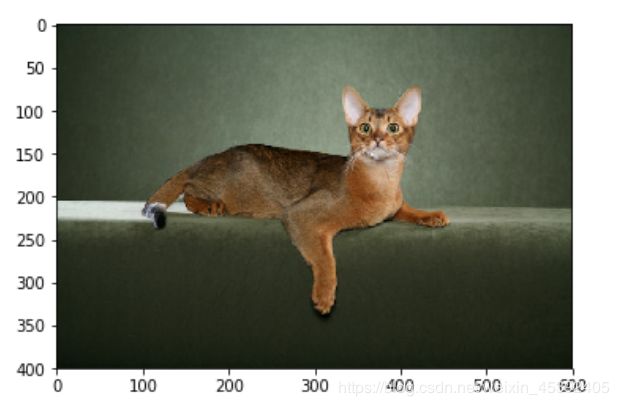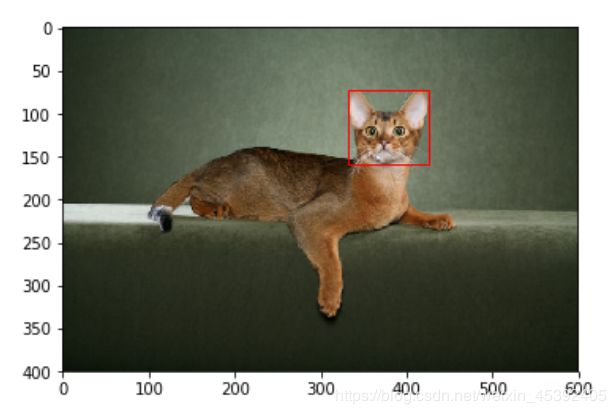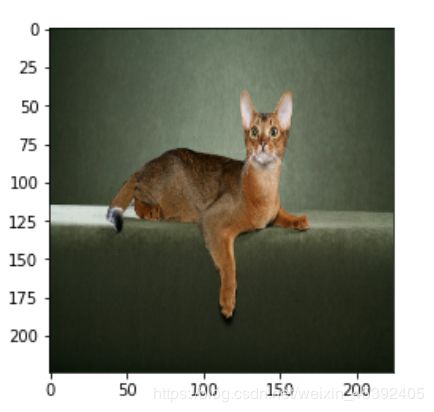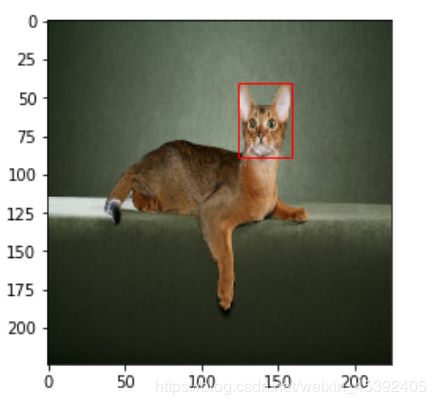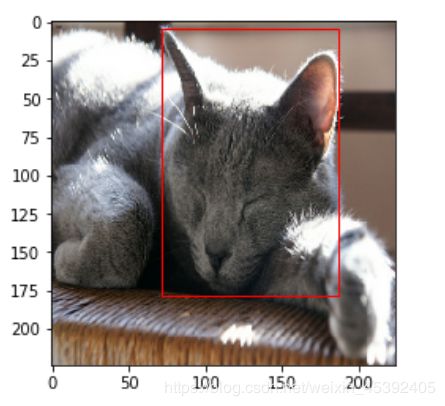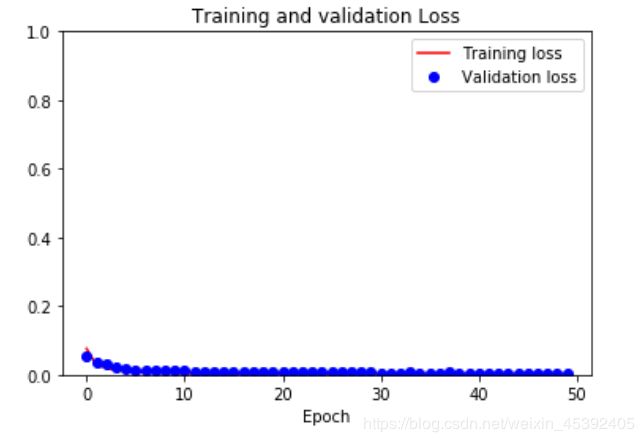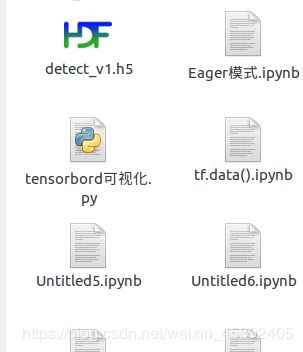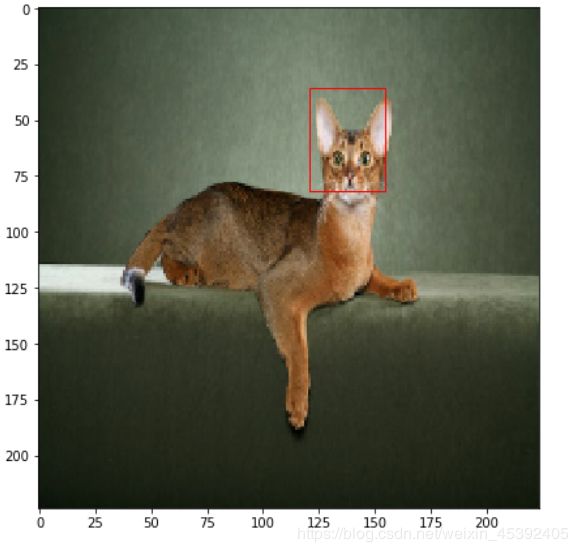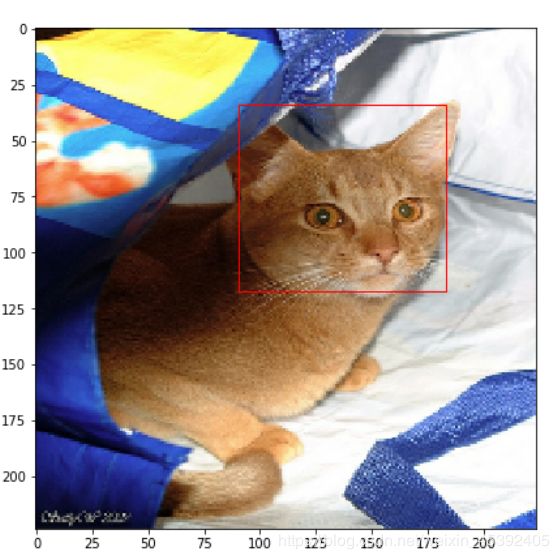Tensorflow2——图像定位
图像定位
- 1、单张图片图像定位
- 2、随意尺度图片定位
- 3、批量图片定位
- 一级目录
给定一副图片,我们要输出四个数字(x,y,w,h),图像中某一个点的坐标(x,y),以及图像的宽度和高度,有了这四个数字,我们可以很容易的找到物体的边框。
1、单张图片图像定位
import tensorflow as tf
import matplotlib.pyplot as plt
%matplotlib inline
import numpy as np
from lxml import etree
import glob
from matplotlib.patches import Rectangle
img=tf.io.read_file("./location/images/Abyssinian_1.jpg")
img=tf.image.decode_jpeg(img)
plt.imshow(img)
xml=open("./location/annotations/xmls/Abyssinian_1.xml").read()
#解析
sel=etree.HTML(xml) #建立好选择器
width=int(sel.xpath("//size/width/text()")[0])
height=int(sel.xpath("//size/height/text()")[0])
xmin=int(sel.xpath("//bndbox/xmin/text()")[0])
xmax=int(sel.xpath("//bndbox/xmax/text()")[0])
ymin=int(sel.xpath("//bndbox/ymin/text()")[0])
ymax=int(sel.xpath("//bndbox/ymax/text()")[0])
#根目录下的size里的width,取出text文本
#这样解析出来的是一个列表,列表里面放置的有文本
## width,height,xmin,xmax,ymin,ymax
#(600, 400, 333, 425, 72, 158)
plt.imshow(img)
rec=Rectangle((xmin,ymin),(xmax-xmin),(ymax-ymin),fill=False,color="red") #最下角的值就是xmin,ymin
ax=plt.gca() #获取当前图像
ax.axes.add_patch(rec)
2、随意尺度图片定位
(代码紧接上)
img=tf.image.resize(img,(224,224))
img=img/255
plt.imshow(img)
xmin=(xmin/width)*224
xmax=(xmax/width)*224
ymin=(ymin/height)*224
ymax=(ymax/height)*224
plt.imshow(img)
rec=Rectangle((xmin,ymin),(xmax-xmin),(ymax-ymin),fill=False,color="red") #最下角的值就是xmin,ymin
ax=plt.gca() #获取当前图像
ax.axes.add_patch(rec)
3、批量图片定位
创建输入管道
数据读取与预处理
获取图像的路径
images=glob.glob("./location/images/*.jpg")
#获取目标值
xmls=glob.glob("./location/annotations/xmls/*.xml")
#拿到这3686张图片(与xml文件对应的)
name = [x.split("\\")[-1].split(".xml")[0] for x in xmls]
如何取出这些名称中的images呢?
imgs_train=[img for img in images if (img.split("\\")[-1].split(".jpg")[0]) in name]
数据集划分
test_count=int(len(imgs_train)*0.2)
train_count=len(imgs_train)-test_count
def to_labels(path):
#读取路径
xml=open("{}".format(path)).read()
sel=etree.HTML(xml)
width=int(sel.xpath("//size/width/text()")[0])
height=int(sel.xpath("//size/height/text()")[0])
xmin=int(sel.xpath("//bndbox/xmin/text()")[0])
xmax=int(sel.xpath("//bndbox/xmax/text()")[0])
ymin=int(sel.xpath("//bndbox/ymin/text()")[0])
ymax=int(sel.xpath("//bndbox/ymax/text()")[0])
return [xmin/width,ymin/height,xmax/width,ymax/height]
labels=[to_labels(path) for path in xmls] #每个label里面包含x的最小值,x的最大值,y的最小值,y的最大值
out_1,out_2,out_3,out_4=list(zip(*labels)) #把xmin,ymin,xmax,ymax分别弄在一起
out_1=np.array(out_1)
out_2=np.array(out_2)
out_3=np.array(out_3)
out_4=np.array(out_4)
标签数据集
label_datasets=tf.data.Dataset.from_tensor_slices((out_1,out_2,out_3,out_4))
def load_image(path):
image=tf.io.read_file(path)
image=tf.image.decode_jpeg(image,channels=3)
image=tf.image.resize(image,(224,224))
image=image/255
return image
图片数据集处理
image_dataset=tf.data.Dataset.from_tensor_slices(imgs_train)
image_dataset=image_dataset.map(load_image)
图片数据集与标签数据集整合
dataset=tf.data.Dataset.zip((image_dataset,label_datasets))
划分数据集
dataset_train=dataset.skip(test_count)
dataset_test=dataset.take(test_count)
BATCH_SIZE=8
BUFFER_SIZE=300
STEPS_PER_EPOCH=train_count//BATCH_SIZE
VALIDATION_STEPS=test_count//BATCH_SIZE
训练数据集与测试数据集的处理
dataset_train=dataset_train.shuffle(BUFFER_SIZE).batch(BATCH_SIZE).repeat()
dataset_train=dataset_train.prefetch(buffer_size=tf.data.experimental.AUTOTUNE)
dataset_test=dataset_test.batch(BATCH_SIZE)
图像定位
for img,label in dataset_train.take(1): #这里的take(1)是取出一个batch出来,这里的img是一个batch
#这里的img和label都是tensor
plt.imshow(tf.keras.preprocessing.image.array_to_img(img[0]))
out_1,out_2,out_3,out_4=label
xmin,ymin,xmax,ymax=out_1[0].numpy()*224,out_2[0].numpy()*224,out_3[0].numpy()*224,out_4[0].numpy()*224
rec=Rectangle((xmin,ymin),(xmax-xmin),(ymax-ymin),fill=False,color="red") #最下角的值就是xmin,ymin
ax=plt.gca() #获取当前图像
ax.axes.add_patch(rec)
xception=tf.keras.applications.Xception(weights="imagenet",include_top = False,input_shape=(224,224,3))
#函数式API
inputs=tf.keras.layers.Input(shape=(224,224,3))
x=xception(inputs)
x=tf.keras.layers.GlobalAveragePooling2D()(x)
x=tf.keras.layers.Dense(2048,activation="relu")(x)
x=tf.keras.layers.Dense(256,activation="relu")(x)
out_1=tf.keras.layers.Dense(1)(x) #这里是做回归,不需要激活函数
out_2=tf.keras.layers.Dense(1)(x)
out_3=tf.keras.layers.Dense(1)(x)
out_4=tf.keras.layers.Dense(1)(x)
prediction=[out_1,out_2,out_3,out_4]
model=tf.keras.models.Model(inputs=inputs,outputs=prediction)
编译模型
model.compile(tf.keras.optimizers.Adam(lr=0.0001),loss="mse",metrics=["mae"])
训练模型
Epochs=50
history=model.fit(dataset_train,epochs=Epochs,steps_per_epoch=STEPS_PER_EPOCH,validation_steps=VALIDATION_STEPS,validation_data=dataset_test)
…
loss=history.history["loss"]
val_loss=history.history["val_loss"]
epochs=range(Epochs)
plt.figure()
plt.plot(epochs,loss,"r",label="Training loss")
plt.plot(epochs,val_loss,"bo",label="Validation loss")
plt.title("Training and validation Loss")
plt.xlabel("Epoch")
plt.ylim([0,1])
plt.legend()
plt.show()
model.save("detect_v1.h5")
new_model=tf.keras.models.load_model("detect_v1.h5")
新模型预测
plt.figure(figsize=(8,24))
for img,_ in dataset_test.take(1):
out_1,out_2,out_3,out_4 = new_model.predict(img)
for i in range(3):
plt.subplot(3,1,i+1) #画三行一列的第一个图像
plt.imshow(tf.keras.preprocessing.image.array_to_img(img[i]))
xmin,ymin,xmax,ymax = out_1[i]*224,out_2[i]*224,out_3[i]*224,out_4[i]*224
rect=Rectangle((xmin,ymin),(xmax-xmin),(ymax-ymin),fill=False,color="red")
ax=plt.gca()
ax.axes.add_patch(rect)
